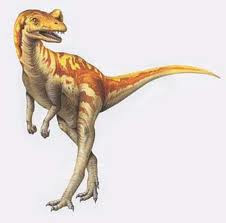
Proceratosaurus a small sized dinosaur with fine peak on nose lived during Middle Jurassic period 175 million years ago.
It is about 9 feet long and 500 pounds.
This theropod dinosaur was carnivorous.
Its skull was first discovered in England way back in 1910.
Proceratosaurus was thought to have been related to the similarly crested Ceratosaurus, which lived much later.
Today, though, paleontologists identify this middle-Jurassic predator as more similar to small, early theropods like Coelurus and Compsognathus.
Despite its relatively small size, Proceratosaurus was one of the biggest hunters of its day, since the tyrannosaurs and other large theropods of the middle Jurassic had yet to reach their maximum sizes.
It was quite likely a very fast predator.
Its skull had a nasal horn at the front and sharply pointed recurved and serrated teeth.
The type specimen is held in the London Museum of Natural History and was recovered in 1910 at Minchinhampton while excavating for a reservoir.
Arthur Smith Woodward, who initially studied Proceratosaurus, originally thought it to be an ancestor of the Late Jurassic Ceratosaurus, due to the similarity of their nasal crests.
Later study during the 1930s by Friedrich von Huene supported this interpretation, and Huene thought both dinosaurs represented members of the group Coelurosauria.
The first major re-evaluation of Proceratosaurus and its relationships was published in 2010 by Oliver Rauhut and colleagues.
Several phylogenetic studies in the early 21st century finally found Proceratosaurus (as well as Ornitholestes) to be a coelurosaur, only distantly related to the ceratosaurids and allosauroids, though one opinion published in 2000 considered Proceratosaurus a ceratosaurid without presenting supporting evidence.
It is about 9 feet long and 500 pounds.
This theropod dinosaur was carnivorous.
Its skull was first discovered in England way back in 1910.
Proceratosaurus was thought to have been related to the similarly crested Ceratosaurus, which lived much later.
Today, though, paleontologists identify this middle-Jurassic predator as more similar to small, early theropods like Coelurus and Compsognathus.
Despite its relatively small size, Proceratosaurus was one of the biggest hunters of its day, since the tyrannosaurs and other large theropods of the middle Jurassic had yet to reach their maximum sizes.
It was quite likely a very fast predator.
Its skull had a nasal horn at the front and sharply pointed recurved and serrated teeth.
The type specimen is held in the London Museum of Natural History and was recovered in 1910 at Minchinhampton while excavating for a reservoir.
Arthur Smith Woodward, who initially studied Proceratosaurus, originally thought it to be an ancestor of the Late Jurassic Ceratosaurus, due to the similarity of their nasal crests.
Later study during the 1930s by Friedrich von Huene supported this interpretation, and Huene thought both dinosaurs represented members of the group Coelurosauria.
The first major re-evaluation of Proceratosaurus and its relationships was published in 2010 by Oliver Rauhut and colleagues.
Several phylogenetic studies in the early 21st century finally found Proceratosaurus (as well as Ornitholestes) to be a coelurosaur, only distantly related to the ceratosaurids and allosauroids, though one opinion published in 2000 considered Proceratosaurus a ceratosaurid without presenting supporting evidence.
Visit: Art and Science of Leadership (5th Edition) by Nahavandi

No comments:
Post a Comment